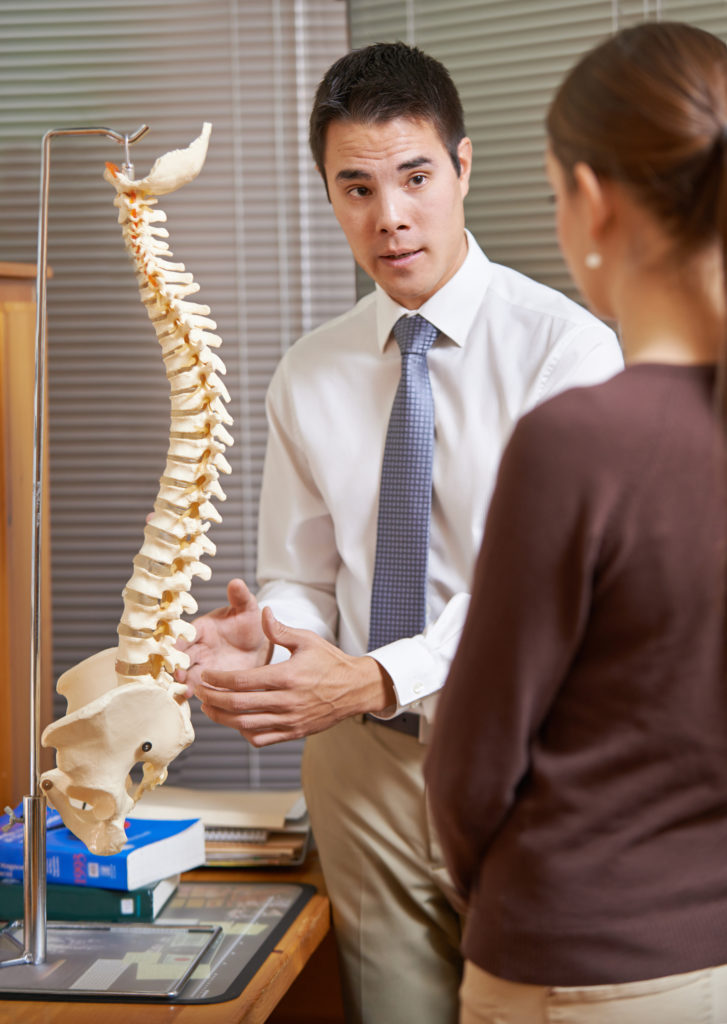

Beliefs and Goals of Chiropractic Medicine
Chiropractic treatment focuses on the inextricable connection between the nervous system and spine, recognizing that biomechanical and structural misalignment and damage to the spine impact the nervous system. The goal of chiropractic treatment is to restore structural integrity to the spine, reduce pressure on neurological tissue, and reestablish normal mobility. With this treatment, the hopes are that pain and inflammation will be reduced or eliminated – especially chronic pain – and normal movement and reflexes will return.
Another big tenet of chiropractic medicine focuses on awareness and accountability for patient-driven health and exercise. This includes practicing good posture, eating right, and trying to be as fit and active as possible. Many people tend to have a sedentary lifestyle, either by choice or profession, and unless proper ergonomic methods are followed, the spine’s health is directly impaired.
The Spine
The spine is a complex composition of 24 bones (vertebrae), separated with gel-like cushions (discs), muscles, joints, nerves and connective tissues. The spinal cord transmits impulses throughout the body via the nervous system. Pain is caused by pinched nerves, displaced vertebrae, inflammation in joints, tendons or muscles, and herniated or ruptured discs.
The chiropractic philosophy believes that symptoms, illness and diseases occur due to mechanical compressions and irritation to the spinal nerves and joints. These symptoms are known as “vertebral subluxation.”
The entire human body, and all its organs are connected to the nervous system. Hence compressions in a nerve induce symptoms throughout its length. A chiropractor thus takes a holistic approach to treat the whole body, and not just individual areas or organs.
Conditions Treated by Chiropractors
- Headaches
- Sleep apnea
- Neck pain
- Disc issues
- Joint pain and stiffness
- Arthritic pain
- Repetitive strains
- Muscle spasms
- Lower back, arm, or leg pain
- Sciatica
- Sports and athletic injuries
- Car accident injuries
- Pregnancy and infertility related problems
The Chiropractic Adjustment – Methods & Techniques
A chiropractic adjustment, is also called a chiropractic, manual, or spinal manipulation. Chiropractors apply manipulation to vertebrae that present abnormal movement or functionality.
The objective is to reduce subluxation, increase range of motion and functionality, and reduce nerve inflammation. The body is realigned, stress is reduced and natural energies are allowed to repair the damage and heal the body.
A chiropractic adjustment typically involves:
- A high velocity, low amplitude (HVLA) short, lever arm thrust to abnormal vertebrae.
- Chiropractic mobilization – low velocity manipulation involving stretching and moving of affected muscles and joints to increase range of motion.
- Joint cavitation – an expulsion of oxygen, nitrogen, and carbon dioxide
- Release of pressure on the affected area
Specialized Adjustment Methods
- Toggle Drop – pressing down with crossed hands and thrusting firmly to adjust a particular area of the spine.
- Lumbar Roll – the patient lies on his side; a quick, precise manipulative thrust is applied to the misaligned vertebra.
- Release Work – gentle pressure applied using fingertips.
- Table adjustments – uses a special table with drop-down sections. The chiropractor applies a quick thrust as the section drops, allowing a lighter adjustment without twisting.
- Instrument adjustments – uses a spring-loaded activator instrument.
- Manipulation under anesthesia (MUA) – performed by a certified chiropractor in a hospital outpatient setting if patient does not respond to traditional adjustments.
Specialized Adjustment Techniques
- Activator Methods –Activator Adjusting Instrument emits regular, mechanical low-force, high-speed impulses to the body.
- Active Release Techniques – soft tissue technique to treat issues with muscles, nerves, ligaments, tendons, and fascia.
- Cox Flexion-Distraction – utilizes special tables with movable parts, which stretch and decompress spinal facets and ligaments gently.
- Diversified – uses specific manual thrusts to restore normal biomechanical function.
- Gonstead Technique – a specific method of analysis by the use of nervoscopes, full spine X-rays, and precise adjusting techniques.
- Hole-in-one Technique/Toggle Recoil Technique – utilizes a quick thrust and release manipulation and incorporates a drop table.
- Logan Basic Technique – a light touch technique to “level the foundation”, or sacrum.
- Thompson Terminal Point Technique (Thompson Drop-Table Technique) – a precision adjusting table with a weighing mechanism.
Additional Chiropractic Treatments & Therapies
In addition to the different adjustment techniques performed by chiropractors, they employ many different treatment modalities that help reduce pain and restore mobility, including:
- Ultrasound-guided injections
- 3D active traction
- Laser therapy
- Graston Technique
- Anti-gravity treadmill
- Myofascial release
Other treatments and therapeutic approaches in combination with chiropractic adjustment include heat and ice application, stretching & exercise, Acupuncture, massage therapy, electrical stimulation, and nutritional counseling and weight loss.
To find out more about chiropractic treatment and how it can help you, please request an appointment online. At Delaware Back Pain & Sports Rehabilitation Centers, we have several locations to make treatment as convenient as possible to our patients.


